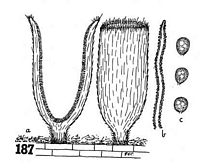|
 Flagelloscypha aotearoa Flagelloscypha aotearoa
SynonymsLachnella aotearoa
BiostatusPresent in region - Indigenous. Endemic
Images (click to enlarge)
Caption: FIG. 187. Lachnella aotearoa. Habit sketch (a) of pilei attached by bases and of the
rudimentary subiculum; (b) encrusted hair from the pileus surface; (c) obovate spores. |
Article: Cunningham, G.H. (1963). The Thelephoraceae of Australia and New Zealand. New Zealand Department of Scientific and Industrial Research, Bulletin 145: 359 p. Wellington:.
Description: Pilei annual, crowded in linear groups associated with a delicate white subiculum,
membranous, fragile, cupulate or as often infundibuliform, attached by or pendent
from narrow bases, 0.1-0.5 mm diameter, 0.25-1 mm long; pileus surface white,
tomentose, abhymenial hairs tortuous, tapering to bluntly acuminate apices,
aseptate, unbranched, to 3 µ diameter, walls 0.25 µ thick, hyaline, densely encrusted
with fine crystals; margin inturned, fimbriate; hymenial surface even, concave,
white or ivory. Context white, to 60 µ thick, of parallel hyphae radiately arranged;
generative hyphae to 3 µ diameter, walls 0.2 µ thick, hyaline. Hymenial layer to 30
µ deep, a close palisade of basidia and paraphyses. Basidia clavate, 10-16 x 5-6 µ,
bearing 4 spores; sterigmata slightly arcuate, slender, to 5 µ long. Paraphyses
clavate, 8-12 x 4-5 µ. Spores broadly obovate, pip-shaped, or subglobose, apiculate,
4.5-5 x 3.5-4.5 µ, walls smooth, hyaline, 0.1 µ thick.
Habitat: HABITAT: Crowded on bark of dead branches.
Distribution: TYPE LOCALITY: Henderson Valley, Auckland, New Zealand.
DISTRIBUTION: New Zealand.
Notes: The delicate white subiculum, delicate walls of the small pilei, acuminate, hyaline,
encrusted abhymenial hairs, and small obovate or pip-shaped apiculate spores
separate the species from others of the section.
|